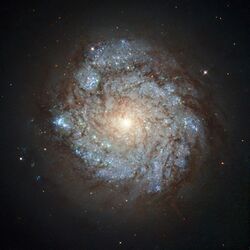Astronomy:NGC 278
| NGC 278 | |
|---|---|
 NGC 278 by HST | |
| Observation data (J2000 epoch) | |
| Constellation | Cassiopeia |
| Right ascension | 00h 52m 04.3s[1] |
| Declination | +47° 33′ 02″[1] |
| Redshift | 0.002090[2] |
| Helio radial velocity | 627±1 km/s[1] |
| Distance | 39 Mly (12.1 Mpc)[3] |
| Group or cluster | Virgo Supercluster[4] |
| Apparent magnitude (V) | 11.5[1] |
| Absolute magnitude (B) | −19.6[2] |
| Characteristics | |
| Type | SAB(rs)b[3] |
| Apparent size (V) | 2′.1 × 2′.0[2] |
| Other designations | |
| UGC 528,[1] PGC 3051[1] | |
NGC 278 is an isolated[3] spiral galaxy in the northern circumpolar constellation of Cassiopeia, near the southern constellation boundary with Andromeda. It lies at a distance of approximately 39 megalight-years from the Milky Way, giving it a physical scale of 190 ly (58 pc) per arcsecond.[3] The galaxy was discovered on December 11, 1786 by German-born astronomer William Herschel. J. L. E. Dreyer described it as, "considerably bright, pretty large, round, 2 stars of 10th magnitude near".[5]
The morphological classification of this galaxy is SAB(rs)b,[3] which indicates a weak bar structure around the nucleus (SAB), an incomplete ring around the bar (rs), and moderately-tightly wound spiral arms (b). It is a relatively small, compact spiral[3] with a diameter of 23 kly (7 kpc),[2] multiple flocculent arms and a bright, dusty nucleus that does not appear to be active.[3] However, the neutral hydrogen in the galaxy is spread over a diameter five times larger than its visible size.[2]
Although it appears nearly face-on, the galactic plane is inclined by an angle of 28° to the line of sight from the Earth, with the major axis being oriented along a position angle of 116°.[3] The outer part of the disk appears to be warped, so that the major axis is not quite perpendicular to the minor axis,[6] and the morphology is somewhat disrupted.[2] The inner disk contains multiple intense star-forming regions.[3] This is taking place in an inner ring with a radius of 6.5 kly (2 kpc) that may have been triggered by a merger with a smaller companion.[4] It has an H II nucleus.[7]
References
- ↑ 1.0 1.1 1.2 1.3 1.4 1.5 "NASA/IPAC Extragalactic Database". Results for NGC 278. http://nedwww.ipac.caltech.edu/cgi-bin/nph-objsearch?objname=NGC+278&img_stamp=yes&extend=no.
- ↑ 2.0 2.1 2.2 2.3 2.4 2.5 Sánchez-Gil, M. Carmen et al. (December 2015). "Corrugated velocity patterns in the spiral galaxies: NGC 278, NGC 1058, NGC 2500 & UGC 3574". Monthly Notices of the Royal Astronomical Society 454 (4): 3376–3390. doi:10.1093/mnras/stv2206. Bibcode: 2015MNRAS.454.3376S.
- ↑ 3.0 3.1 3.2 3.3 3.4 3.5 3.6 3.7 3.8 Israel, F. P. (November 2009). "CI and CO in nearby galaxy centers. The star-burst galaxies NGC 278, NGC 660, NGC 3628 NGC 4631, and NGC 4666". Astronomy and Astrophysics 506 (2): 689–702. doi:10.1051/0004-6361/200811586. Bibcode: 2009A&A...506..689I.
- ↑ 4.0 4.1 Knapen, J. H. et al. (August 2004). "The nuclear ring in the unbarred galaxy NGC 278: Result of a minor merger?". Astronomy & Astrophysics 423 (2): 481–493. doi:10.1051/0004-6361:20034336. Bibcode: 2004A&A...423..481K.
- ↑ Seligman, Courtney. "NGC Objects: NGC 250 - 299". Celestial Atlas. https://cseligman.com/text/atlas/ngc2a.htm#278.
- ↑ Garrido, O. et al. (February 2003). "GHASP: An Hα kinematic survey of spiral and irregular galaxies. II. Velocity fields and rotation curves of 15 galaxies". Astronomy & Astrophysics 399: 51–61. doi:10.1051/0004-6361:20021784. Bibcode: 2003A&A...399...51G.
- ↑ Ho, Luis C.; Filippenko, Alexei V.; Sargent, Wallace L. W. (October 1997). "A Search for 'Dwarf' Seyfert Nuclei. III. Spectroscopic Parameters and Properties of the Host Galaxies". Astrophysical Journal Supplement 112 (2): pp. 315–390. doi:10.1086/313041. Bibcode: 1997ApJS..112..315H.
External links
Coordinates: ![]() 00h 52m 04.3s, +47° 33′ 02″
00h 52m 04.3s, +47° 33′ 02″
 |

